
CMS57opmtr cince Week 9:Online Algorithms Instructor:Shengyu Zhang 1
Instructor: Shengyu Zhang 1

Secretary hiring problem 2
Secretary hiring problem 2

A motivating problem ■Secretary problem: We want to hire a new office assistant. There are a number of candidates. We can interview one candidate each day,but we have to decide the acceptance/rejection immediately. 3
A motivating problem ◼ Secretary problem: ❑ We want to hire a new office assistant. ❑ There are a number of candidates. ❑ We can interview one candidate each day, but we have to decide the acceptance/rejection immediately. 3
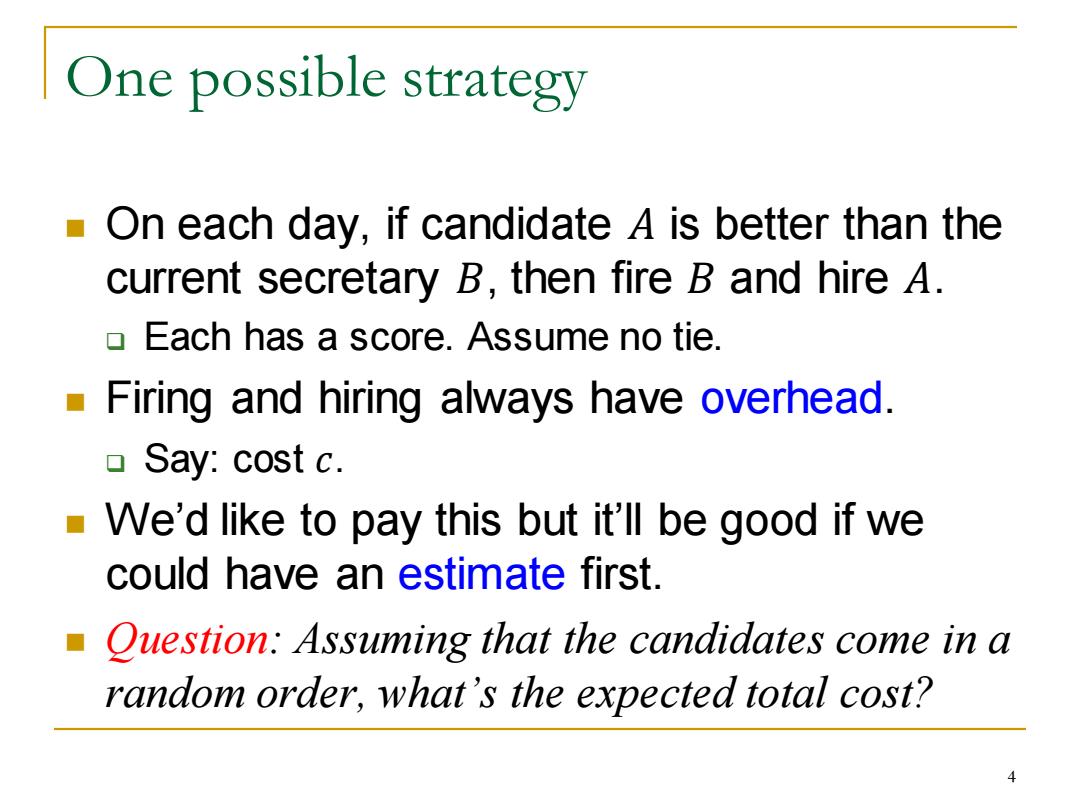
One possible strategy On each day,if candidate A is better than the current secretary B,then fire B and hire A. Each has a score.Assume no tie. Firing and hiring always have overhead. Say:cost c. We'd like to pay this but it'll be good if we could have an estimate first. Question:Assuming that the candidates come in a random order,what's the expected total cost?
One possible strategy ◼ On each day, if candidate 𝐴 is better than the current secretary 𝐵, then fire 𝐵 and hire 𝐴. ❑ Each has a score. Assume no tie. ◼ Firing and hiring always have overhead. ❑ Say: cost 𝑐. ◼ We’d like to pay this but it’ll be good if we could have an estimate first. ◼ Question: Assuming that the candidates come in a random order, what’s the expected total cost? 4
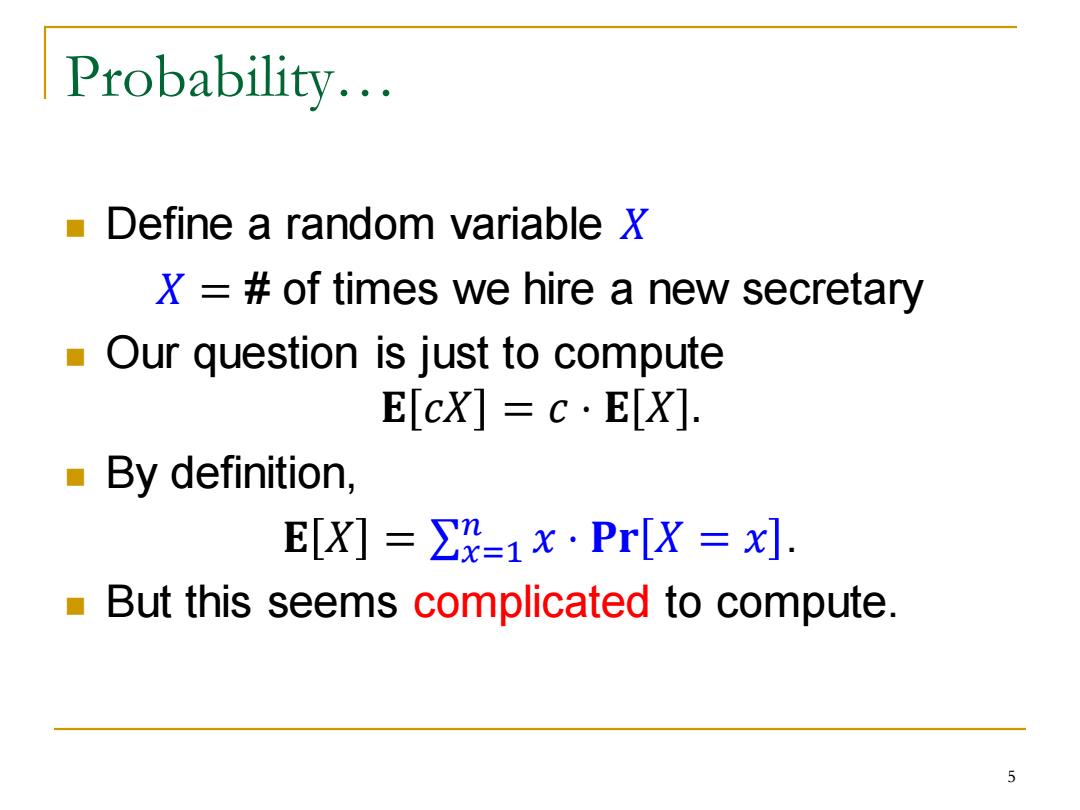
Probability... Define a random variable X X=#of times we hire a new secretary Our question is just to compute E[cX]=c·E[X]. By definition, E[X]=∑x=1x·Pr[X=x]. But this seems complicated to compute. 5
Probability… ◼ Define a random variable 𝑋 𝑋 = # of times we hire a new secretary ◼ Our question is just to compute 𝐄 𝑐𝑋 = 𝑐 ⋅ 𝐄 𝑋 . ◼ By definition, 𝐄 𝑋 = σ𝑥=1 𝑛 𝑥 ⋅ 𝐏𝐫 𝑋 = 𝑥 . ◼ But this seems complicated to compute. 5
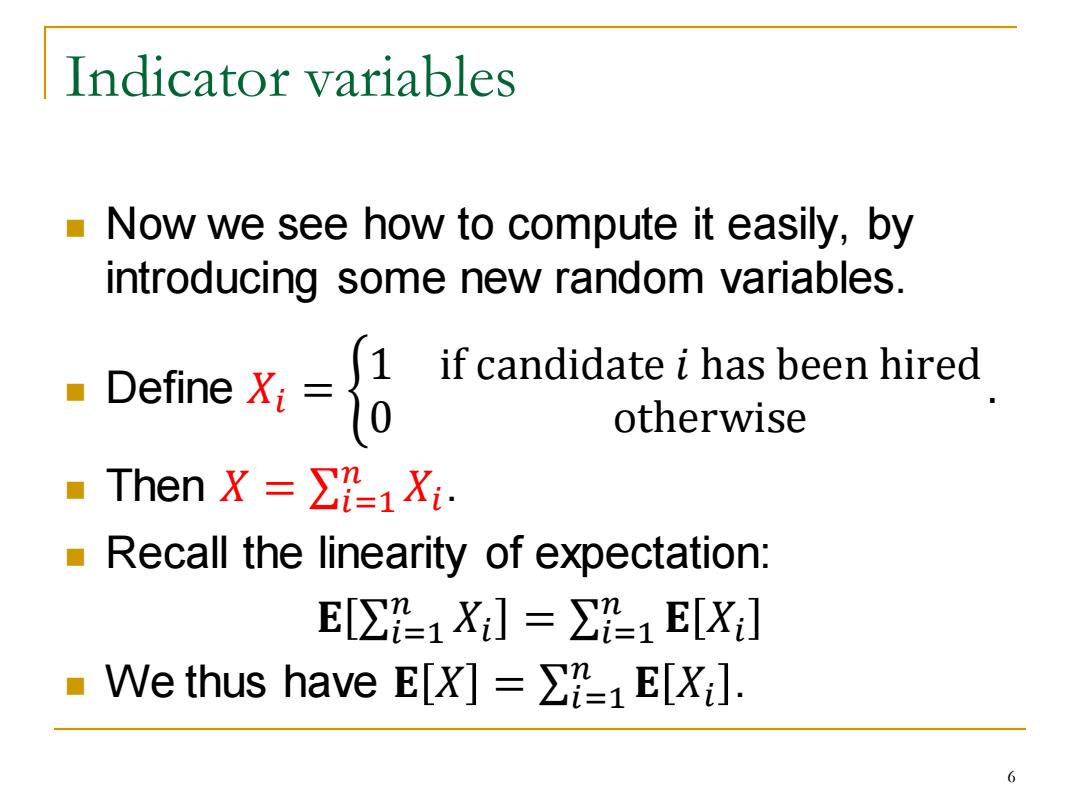
Indicator variables Now we see how to compute it easily,by introducing some new random variables. Define Xi 0 if candidate i has been hired otherwise "Then X=∑1Xi. Recall the linearity of expectation: E[∑1X]=∑1E[X] ·We thus have E[X]=∑1E[x]. 6
Indicator variables ◼ Now we see how to compute it easily, by introducing some new random variables. ◼ Define 𝑋𝑖 = ቊ 1 if candidate 𝑖 has been hired 0 otherwise . ◼ Then 𝑋 = σ𝑖=1 𝑛 𝑋𝑖 . ◼ Recall the linearity of expectation: 𝐄 σ𝑖=1 𝑛 𝑋𝑖 = σ𝑖=1 𝑛 𝐄 𝑋𝑖 ◼ We thus have 𝐄 𝑋 = σ𝑖=1 𝑛 𝐄 𝑋𝑖 . 6
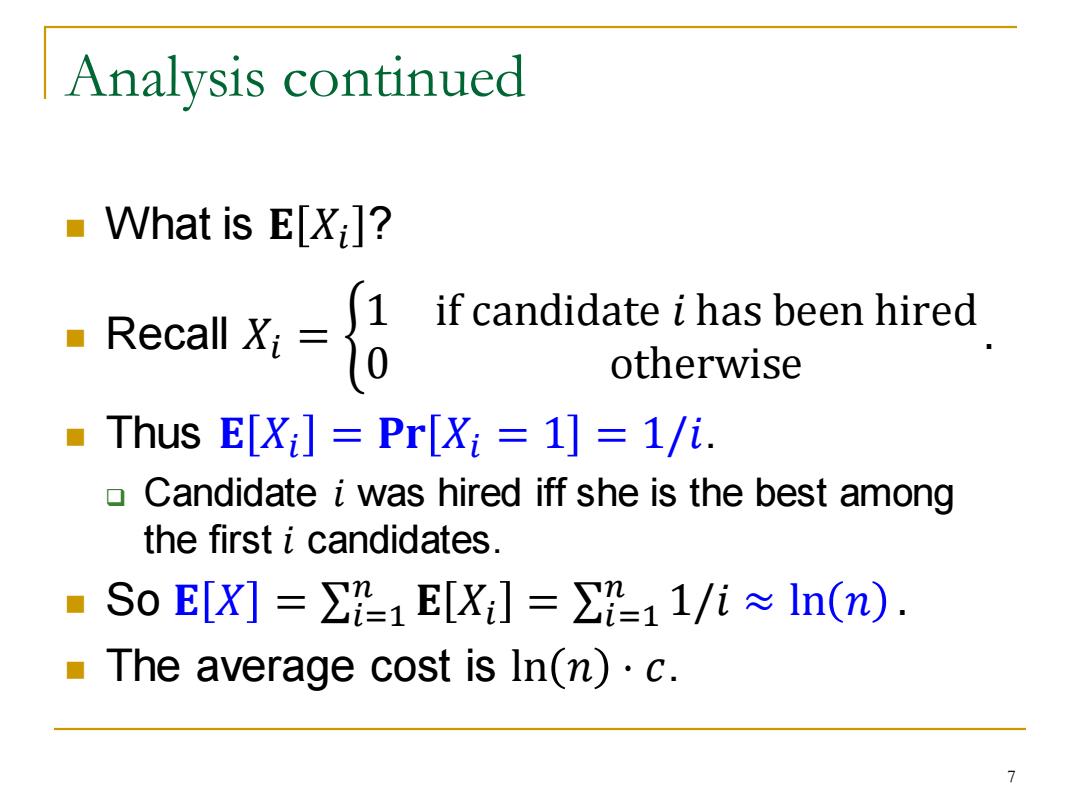
Analysis continued What is EXi? Recall Xi=0 1 if candidate i has been hired otherwise Thus E[Xi]Pr[Xi=1]=1/i. 0( Candidate i was hired iff she is the best among the first i candidates. ■ So E[X]=1E[Xi]=11/i In(n). ■ The average cost is In(n).c
Analysis continued ◼ What is 𝐄 𝑋𝑖 ? ◼ Recall 𝑋𝑖 = ቊ 1 if candidate 𝑖 has been hired 0 otherwise . ◼ Thus 𝐄 𝑋𝑖 = 𝐏𝐫 𝑋𝑖 = 1 = 1/𝑖. ❑ Candidate 𝑖 was hired iff she is the best among the first 𝑖 candidates. ◼ So 𝐄 𝑋 = σ𝑖=1 𝑛 𝐄 𝑋𝑖 = σ𝑖=1 𝑛 1/𝑖 ≈ ln 𝑛 . ◼ The average cost is ln 𝑛 ⋅ 𝑐. 7

Another strategy A more natural scenario is that we only hire once. And of course,we hope to hire the best one. But the candidates on the market also get other offers.So we need to issue offer fast. Interview one candidate each day,and decide acceptance/rejection immediately. The candidates come in a random order. 8
Another strategy ◼ A more natural scenario is that we only hire once. ◼ And of course, we hope to hire the best one. ◼ But the candidates on the market also get other offers. So we need to issue offer fast. ◼ Interview one candidate each day, and decide acceptance/rejection immediately. ◼ The candidates come in a random order. 8
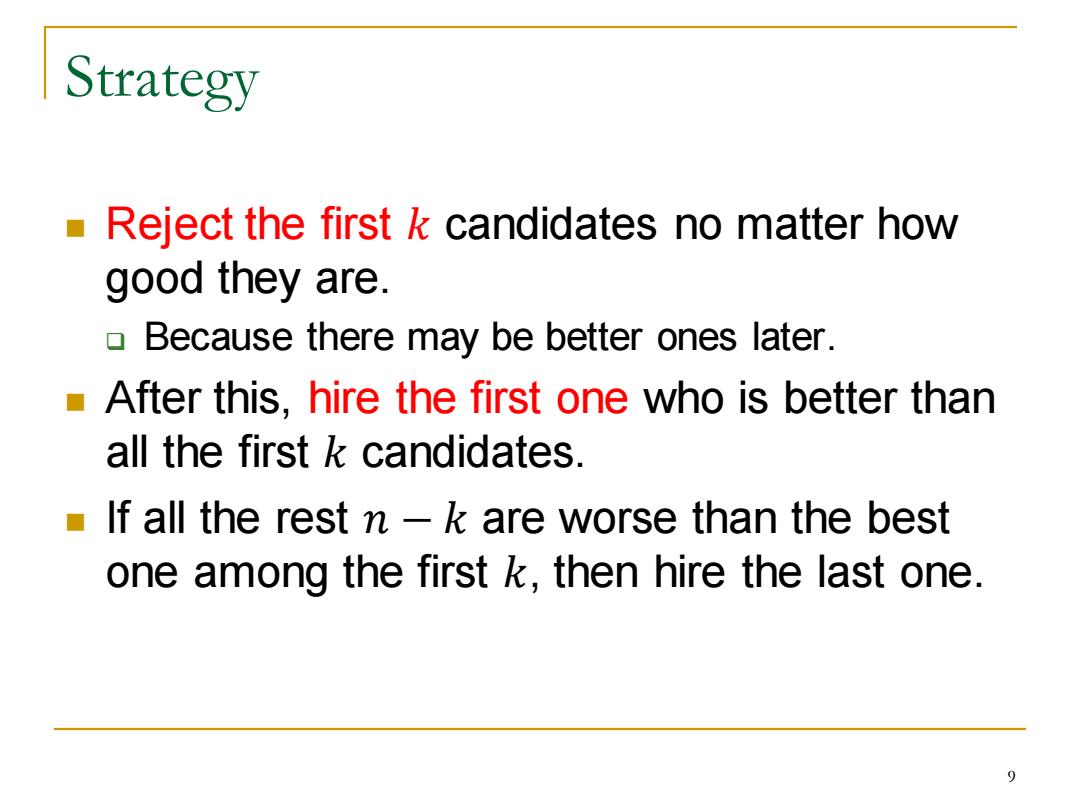
Strategy Reject the first k candidates no matter how good they are. Because there may be better ones later. After this,hire the first one who is better than all the first k candidates. If all the rest n-k are worse than the best one among the first k,then hire the last one
Strategy ◼ Reject the first 𝑘 candidates no matter how good they are. ❑ Because there may be better ones later. ◼ After this, hire the first one who is better than all the first 𝑘 candidates. ◼ If all the rest 𝑛 − 𝑘 are worse than the best one among the first 𝑘, then hire the last one. 9
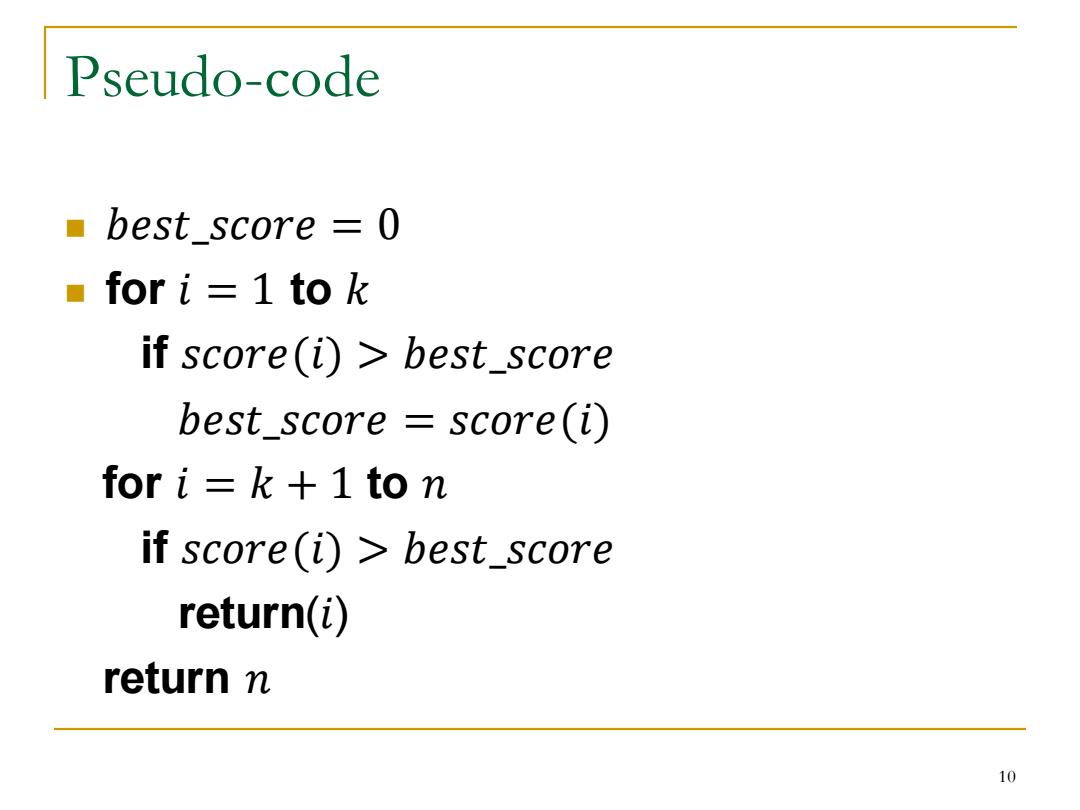
Pseudo-code best score =0 ■fori=1tok if score(i)>best_score best_scorescore(i) for i=k+1 to n if score(i)best_score return(i) return n 10
Pseudo-code ◼ 𝑏𝑒𝑠𝑡_𝑠𝑐𝑜𝑟𝑒 = 0 ◼ for 𝑖 = 1 to 𝑘 if 𝑠𝑐𝑜𝑟𝑒(𝑖) > 𝑏𝑒𝑠𝑡_𝑠𝑐𝑜𝑟𝑒 𝑏𝑒𝑠𝑡_𝑠𝑐𝑜𝑟𝑒 = 𝑠𝑐𝑜𝑟𝑒(𝑖) for 𝑖 = 𝑘 + 1 to 𝑛 if 𝑠𝑐𝑜𝑟𝑒(𝑖) > 𝑏𝑒𝑠𝑡_𝑠𝑐𝑜𝑟𝑒 return(𝑖) return 𝑛 10